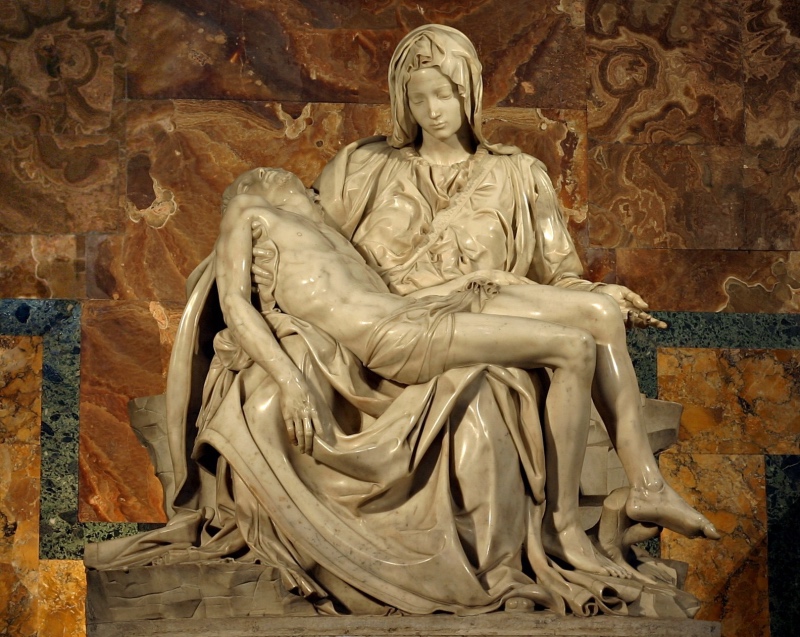
DAVID ADAMS looks at the story behind Michelangelo’s world famous sculpture, Pietá…
Depicting the body of the crucified Christ laying in the lap of his grieving mother Mary, Pietá is widely regarded as one of the great works of Christian art.
Now housed in St Peter’s Basilica in Vatican City within Rome, it is the work of Renaissance artist Michelangelo Buonarroti and was the first of a number of works he created around the same theme.

PICTURE: Stanislav Traykov (licensed under CC BY-SA 3.0/image cropped)
It was commissioned by the French Cardinal Jean de Bilhères whose agreement with the then 24-year-old Michelangelo was that he was to create the “most beautiful work of marble in Rome, one that no living artist could better.”
Sculpted from a single slab of Carrara marble – a white and blue stone which comes from northern Italy, it was completed over the years 1498-1499. It was first displayed in the Chapel of Santa Petronilla in Old St Peter’s – which the cardinal had selected as his funerary chapel – but when this chapel was demolished as part of a 16th and 17th century rebuilding effort, it was moved to its current location just inside the basilica’s main entrance in the first chapel in the north aisle. The chapel is now said to be the second most visited part of the basilica after the tomb of St Peter.
The pyramidical-shaped sculpture depicts what was a popular trope in Europe at the time – an imagined moment showing Mary cradling Jesus after He was taken down from the cross (it’s not recorded in Scripture), known as the ‘Lamentation of Christ’ or as one of the ‘Seven Sorrows of Mary’.
It shows Mary as a young woman – rather too young, given Jesus was 33-years-old at the time of His crucifixion – and the figures, while appearing natural, are actually out of proportion given Jesus was at this stage a full grown man (Michelangelo cleverly uses the drapery Mary is wearing to help the overall effect). The signs of His crucifixion are present in small marks on His hands and feet and an indication of the wound in His side, but His face appears at peace.
The work – which is generally considered the artist’s best sculpture – is the only piece Michelangelo ever signed and the story goes that he did so after he overheard the work being attributed to another sculptor. The signature can be found in a sash across Mary’s chest which reads ‘MICHAELA[N]GELUS BONAROTUS FLORENTIN[US] FACIEBA[T]’ which translates as ‘Michelangelo Buonarroti, Florentine, made this’. It is said he later regretted the decision and vowed never to sign another work.
The work was almost instantly famous and was key in helping to create the reputation the Michelangelo still holds as one of the world’s great artists.
The Pietá has suffered considerable damage in the years since its completion – four fingers on Mary’s hand were broken during a move in 1736 and some think the restoration changed the position of the fingers. The greatest damage occurred on 21st May, 1972, when a mentally disturbed man attacked it with a geologist’s hammer, removing one of Mary’s arms at the elbow, part of her nose and chipping an eyelid. Some of the pieces were taken by onlookers and not returned. As a result, the restored statue is now protected by bulletproof glass.
There was something of a silver living – during the sculpture’s restoration after the attack, the letter ‘M’ was found hidden in the folds of Mary’s left hand, thought to have been left by the artist (perhaps before he signed it with a more obvious signature).
St Peter’s isn’t the only location where the sculpture has been displayed – in 1964 it was loaned to the US and displayed as part of the New York World’s Fair where it was placed behind bullet-proof Plexiglass and viewed by people on a moving walkway.





